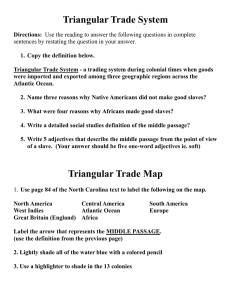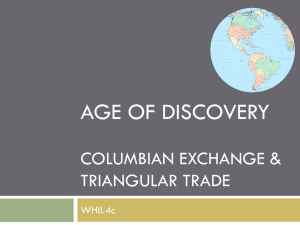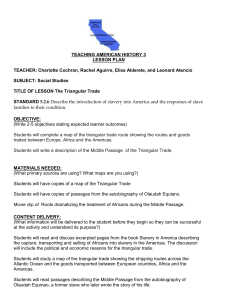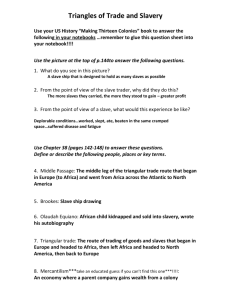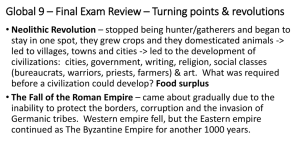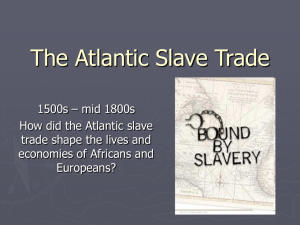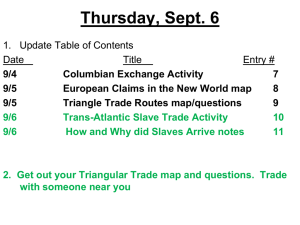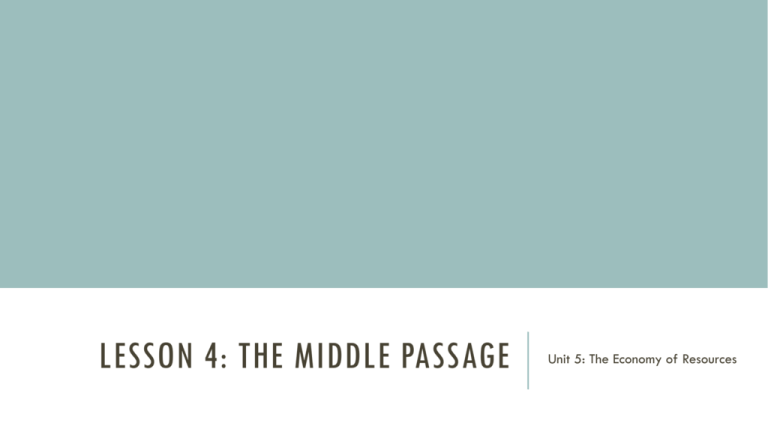
LESSON 4: THE MIDDLE PASSAGE
Unit 5: The Economy of Resources
SMART START
OBAMA VISITS
“DOOR OF NO RETURN”
https://www.youtube.com/watch
?v=bsLkpztXI_k
TRIANGULAR TRADE
The slave trade was also known as the triangular trade
because it has three stages.
•The Triangular Trade is the name given to the trading of
goods and slaves between Europe, Africa and the
Americas.
•The Middle Passage was the specific route from Africa to
the Americas that the slaves were taken on.
•Coastal African states would capture and sell their
enemies – the interior African states – to the Europeans.
•Interdependence is when two groups need each other and
lean on each other to get what they both want. Europeans
wanted slaves and raw goods, Africans wanted gold and
supplies.
TRIANGULAR TRADE: STAGE 1
EUROPE TO WESTERN AFRICA
The Atlantic slave trade has been called the triangular
trade because it had three stages that roughly form the
shape of a triangle when viewed on a map.
The first stage began in Europe, where manufactured
goods such as metals, cloth, guns, and spirits were loaded
onto ships bound for ports on the African coast. There the
goods were exchanged for slaves.
TRIANGULAR TRADE: STAGE 2
AFRICA TO THE AMERICAS
The second stage of the triangular trade was the
shipment of slaves across the Atlantic Ocean, usually to
Brazil or to an island in the Caribbean Sea. This trip,
known as the Middle Passage, took a few weeks to
several months.
TRIANGULAR TRADE: STAGE 2 (CONTINUED)
AFRICA TO THE AMERICAS
The ships were grossly overcrowded, with the captives
wedged below decks and chained to platforms stacked in
tiers. The average space allotted to an individual was just
6 feet long, 16 inches wide, and perhaps 3 feet high (183
by 41 by 91 centimeters). Unable to stand up or turn over,
many captives died in this prone position.
TRIANGULAR TRADE: STAGE 2 (CONTINUED)
AFRICA TO THE AMERICAS
The almost continuous dangers faced by the captives
included epidemic diseases, raids at port by hostile tribes,
and attack by pirates, in addition to physical, sexual, and
psycho-logical abuse at the hands of their captors.
Death rates on the Middle Passage ranged from about
10% to more than 20%.
TRIANGULAR TRADE: STAGE 3
AMERICAS TO EUROPE
After arriving in Brazil or the Caribbean, the slaves were
sold at auction and were taken throughout the New World.
They were put to work on plantations.
The shipment to Europe of plantation crops and products
made from them was the third leg of the triangular trade.
Among the most valuable exports to Europe were sugar,
tobacco, cotton, molasses, and rum.
SLAVE TRADE
For weeks, months, sometimes as long as a year, captured
Africans waited in the dungeons of the slave factories
scattered along Africa's western coast. They had already
made the long, difficult journey from Africa's interior to the
coast -- but just barely. Out of the roughly 20 million who
were taken from their homes and sold into slavery, half
didn't complete the journey to the African coast, most of
those dying along the way.
NOW YOU!
Read and annotate with your elbow group.
STOP!
Let’s talk about Paragraph 5…
What is the first example of control?
What is the first example of an unhealthy condition?
NOW GO: FINISH UP!
Create CONCEPT WEBS for
AFRICAN SLAVERY
TRAINGULAR TRADE
Complete the webs with as many facts from the Guided
Practice reading selection as you can.

